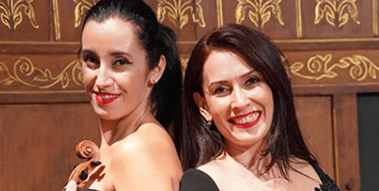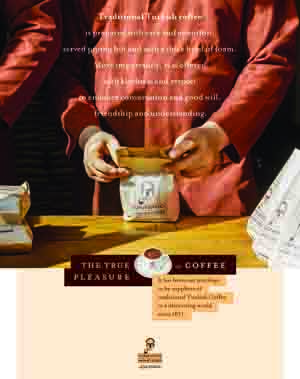On October 16 I made my way to the Süreyya Opera House in Kadıköy to hear violinist Bahar Büyükgönenç and pianist Tutu Aydınoğlu play works by Zoltán Kodály, Johannes Brahms, Manuel de Falla, Robert Schumann and Fikret Amirov. For the first time I had the privilege of sitting in a private box (someone else’s, I hasten to add) at the Süreyya Opera House, and was thus able to rest my trusty notebook on the narrow shelf atop the wall of the box. Usually I have to nurse the notebook in which I write my comments on the performance in my lap, where it is in danger of falling onto the floor each time I clap. The more enthusiastically I applaud, of course, the more likely it is that I will end up fishing for my notebook on the floor in the dark – to the discomfort and annoyance of my neighbours. (Few people enjoy having their ankles groped during a concert. However agreeable the sensation itself may be, it does tend to disturb the concentration.)
Bahar Büyükgönenç began learning the violin with Prof. Nuri İyicil at the Mimar Sinan Fine Arts University State Conservatoire at the age of 11. She then went on to study with Veniamin Varshavskiy at the Istanbul University State Conservatoire. From 2002 to 2005 she was concert master (i.e. leader of the first violins) at the Cemal Reşit Rey Symphony Orchestra. Her association with the CRR Jazz Orchestra, meanwhile, is ongoing. In 2007 she began playing in violin virtuoso Cihat Aşkın’s Aşkın Ensemble, and that same year started teaching at the Istanbul Technical University Turkish Music State Conservatoire. In 2018 she transferred to the Maltepe University Conservatoire, where she currently teaches.
The Azeri pianist Tutu Aydınoğlu began playing the piano at the age of 6, subsequently receiving tuition from Prof. O. Abaskuliyev and Prof. Meral Yapalı. She is currently an academician and teacher at the Istanbul University State Conservatoire. Ms Aydınoğlu is known for her performances of works by Azeri composers. Among these are Fikret Amirov and Elmira Nazirova’s Piano Concerto after Arabian Themes, and Pike Axundova’s İstiklal Triosu (Independence Trio), written to celebrate the centenary in 2018 of the foundation of the Republic of Azerbaijan. In addition she takes an interest in Turkish classical music. As a researcher she has carried out projects on subjects such as ‘Traces of the Ottomans in Western Music’ and ‘Sultan Abdülhamid’s Lost Piano’.
The first item on the duo’s programme on October 16 was the Adagio for Violin and Piano by the Hungarian composer Zoltán Kodály (1882–1967). This piece was unfamiliar to me, and I was pleasantly surprised both by the Adagio itself – an early work, written in 1905, that packs a considerable emotional punch – and by the quality of the performance. I especially appreciated the evenly-played upward arpeggio flourishes produced by the pianist, who was wearing a bright red dress that contrasted with the tortoiseshell tones sported by the violinist. Here is a rendering of the Adagio by two Romanians: violinist and conductor Ştefan Ruha (1931-2004), and pianist and Cluj-Napoca Music Academy professor Ferdinand Weiss (1932-–2002).
The Büyükgönenç-Aydınoğlu musical partnership then launched into the most exacting challenge of the entire evening: Brahms’s Sonata No 3 in D minor for Violin and Piano, a four-movement work written between 1886 and 1888. Frankly, I was surprised to see a piece of this difficulty positioned so early in the programme, and indeed the violinist did not seem entirely comfortable while playing it. (I later found out, via an informant, that her tortoiseshell robe had been in danger of slipping off her shoulders during the Brahms. No doubt it was this circumstance that was making her uneasy.)
The Sonata No 3 in D minor, the last of Brahms’s three violin sonatas, was premiered in Budapest in 1888 with the composer himself at the piano. (Brahms was an excellent pianist, by the way – given the difficulty of his piano concertos, in which he performed as soloist, he had to be.) The violin part, meanwhile, was played by the Hungarian-born German violinist Eugen Huber, a pupil of the celebrated virtuoso Joseph Joachim. Huber adopted the Hungarian name Jenő Hubay while living in the French-speaking world. He eventually became Head of the Liszt Academy of Music in Budapest, where he established the Budapest Quartet with cellist David Popper and took on a leading role in the foundation of the Hungarian school of violin-playing.
Orrin Howard’s programme notes on the ‘LAPhil’ website give you just the right amount of detail about Brahms’s Sonata No 3, a work the author describes as having ‘great urgency, strength and emotional intensity’.
In the performance at the Süreyya Opera House on October 16 coordination between the two musicians was perfect throughout, thereby demonstrating the closeness of the rapport they have built up between them. The difficult piano part was well managed in the ‘stammering, uneasy’ third movement, while the strong rhythm of the ‘frenzied, passionate’ fourth movement was admirably conveyed by both parties. The following rendition of Brahms’s Sonata No 3 in D minor for Violin and Piano is by David Oistrakh (1908-1974) and Sviatoslav Richter (1915–97). The performance takes place at the Lincoln Center, New York, in 1970. I particularly appreciate their interpretation of the (mostly) ‘gentle and lyrical’ second movement, which starts at 08:57.
The next item on the programme was an arrangement for violin and piano of the 1914 Suite populaire espagnole by Manuel de Falla (1876–1946), in which each of the six pieces showcases the folk music of one of the regions of Spain. It was here that the violinist seemed to get well and truly into her stride. In fact, I wished she had played this piece before venturing into Brahms territory. As Spanish music has a special appeal for Turkish people, playing some of it (I thought) might have helped her relax. Be that as it may, both performers were excellent in the de Falla. The violinist gave a full-throated, gutsy rendition that was much appreciated by the audience.
In this recording the Suite populaire espagnole is being played by two Russians: Ilya Kaler (1963–) – the only violinist ever to win the gold medal at the Tchaikovsky Competition in Moscow (1986), the Sibelius Competition in Helsinki (1985) and the Paganini Competition in Genoa (1981) – and pianist Leonid Blok (1936–2016).
After the break, the two performers reappeared on stage having changed into new outfits – a move that was no doubt prompted as much by practical as by aesthetic considerations. This time they were both wearing black. Whatever their motivations for choosing this colour may have been, it was definitely a fortunate choice.
The first piece they played – Schumann’s Sonata No 1 in A minor for Violin and Piano, written in 1851 – was almost as hard a nut to crack as the Brahms in the first half had been. By coincidence October 16, the date of the Schumann sonata’s first performance in 1852, was also the date on which we heard it in Kadıköy. An (unsigned) article on the LA Phil website notes similarities between the style of this work and that of Brahms:
[Schumann] wrote the A-minor Sonata in a few days, and although he said that he didn’t like the way it had turned out, it has a remarkable freshness and relative concision. Structurally the piece could have been a model for Grieg, but the first movement has the sort of surging 6/8 fervour that became a hallmark of Brahms, and the syncopation and play of two beats against three is also Brahmsian.
Joseph DuBose, writing on the Classical Connect website, believes that this sonata reflects Schumann’s emotional reaction to the onset of mental illness the previous year:
By 1850 mental illness began to take its toll on Schumann and those around him. Suffering from violent mood swings, he believed he was ordered by Heaven to compose certain melodies and, subsequently, tormented by demons... Regardless, Schumann’s feverish pace of composition did not wane and the first Violin Sonata was composed in less than a week in September 1851... The first movement is intensely passionate and gives a clear view into the inner torment Schumann must have endured during his final years.
It was in the Schumann that Bahar Büyükgönenç and Tutu Aydınoğlu really came into their own. The violinist seemed to have completely regained her confidence. Her body movements were more fluid, and her intonation in the high register (which had been a trifle shaky in the Brahms) was spot on, even in the double-stopping – i.e., the places where the performer is required to play two notes together, in this case an octave apart. The piano, meanwhile, provided a consistently solid accompaniment. Even in the third movement, which is quite hard on the pianist’s left wrist, there was no sign whatsoever of fatigue. The performance I have chosen to illustrate this work is by Spanish-Armenian violinist Ara Malikian (1968-) and Canadian-Armenian pianist Serouj Kradjian (1973-). Blair Johnston’s programme notes under the YouTube version, though somewhat technical in places, are highly instructive. I don’t agree with his comment on the ending, however: I think it is perfectly satisfactory, and not at all ‘irresolute’:
The feeling of irresolution at the end of the Sonata can by no means be construed as unintentional, but rather must be seen as Schumann’s effort to honestly explore the depths of his own increasingly agitated and complex mind, regardless of whether or not the resulting product corresponded with pre-existing musical values.
The final item on the programme for the concert on October 16 consisted of movements 2, 3 and 4 of the 1979 Four Pieces for Violin and Piano by the Azeri composer Fikret Amirov (1922–84). Amirov, born in Ganja, Azerbaijan, studied at the Baku Music Academy, where his teachers were the composer and pedagogue Boris Zeidman (1909–82) and Uzeyir Hajibeyov (1885–1948), a composer, musicologist and teacher who is known as ‘the father of Azerbaijani classical music’. In this performance of the Four Pieces, the violinist is Sarvar Ganiyev and the pianist Namiq Sultanov.
Both Bahar Büyükgönenç and Tutu Aydınoğlu were once again on top of their game in the Amirov, giving a textbook demonstration of perfect coordination. For their encore they played an emotionally-charged piece entitled Leyla by the Azeri composer and pianist İlyas Mirzayev, who came on stage to take a bow at the end. Here the violinist excelled herself with spot-on intonation in the high register and flawless double-stopping. The pianist, meanwhile, was – as indeed she had been throughout the evening – a model of cast-iron technical competence and discreet diplomacy, invariably treating the soloist with consideration. In this recording of Leyla, in which the Agora Orchestra is being conducted by Murat Ömür Tuncer, the violinist is Elvin Hoxha Ganiyev, while the piano accompaniment is provided by none other than İlyas Mirzayev, the composer.
It is encouraging to know that Turkey has so many dedicated musicians who are willing to make sacrifices to achieve perfection in their art. The violinist Bahar Büyükgönenç and pianist Tutu Aydınoğlu definitely fall into this category, and any further concerts by this duo will certainly be worth looking in on. It was with much satisfaction that I closed my notebook after this concert. I dropped my pen into the audience below, it is true, but everything has its price, and – as I have just remarked – some sacrifices are absolutely worth making.








